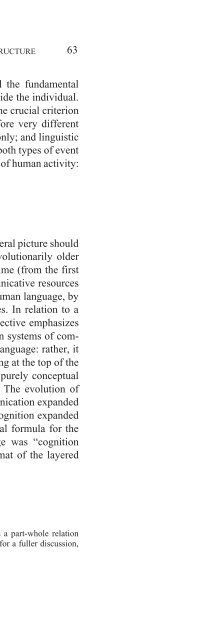Cognitive Semantics : Meaning and Cognition
Cognitive Semantics : Meaning and Cognition
Cognitive Semantics : Meaning and Cognition
You also want an ePaper? Increase the reach of your titles
YUMPU automatically turns print PDFs into web optimized ePapers that Google loves.
136 ELISABETH ENGBERG-PEDERSEN<br />
we see ‘his’ staying ‘there’ as part of a journey over a l<strong>and</strong>scape where the<br />
passage corresponding to ‘his’ time ‘there’ includes a vast (i.e. long) part of<br />
the l<strong>and</strong>scape.<br />
Both Lakoff <strong>and</strong> Johnson (1980) <strong>and</strong> Lakoff (1993) avoid including the<br />
notion of ego or a specific point of view in their models in contrast with the<br />
earlier models, the moving-ego vs. moving-time models. In many cases,<br />
however, we have to reckon with the notion of ego — or a specific point of<br />
view, since verbs such as English come are primarily deictic <strong>and</strong> denote<br />
motion towards ego or some individual from whose point of view the events<br />
are seen (Fillmore 1973). In (4a-b) time can be said to be assigned front-back<br />
orientation simply because it is seen as moving, as pointed out by Lakoff <strong>and</strong><br />
Johnson (1980) <strong>and</strong> Lakoff (1993). But the direction of movement (come vs.<br />
go) is determined by the point of view: time comes towards ego’s front <strong>and</strong><br />
goes away behind ego’s back.<br />
What we have seen up to now is that all models for describing temporal<br />
expressions in spoken languages are basically dynamic, no matter whether the<br />
expressions are semantically static as in (1) <strong>and</strong> (5) or dynamic as in (2-4).<br />
Time is seen as stationary with an individual moving as if over a l<strong>and</strong>scape. Or<br />
time is seen as an object moving, either independently of ego or a specific<br />
point of view or in relation to ego.<br />
Traugott (1978: 382) criticizes descriptions of temporal expressions in<br />
terms of moving-ego <strong>and</strong> moving-time: according to her not all temporal<br />
expressions are dynamic, <strong>and</strong> static temporal expressions should not be described<br />
in terms of motion. Static temporal expressions such as the ones in (1)<br />
use ego’s front-back orientation; here neither ego nor time are conceptualized<br />
as moving.<br />
As an alternative to the moving-time <strong>and</strong> the moving-ego models,<br />
Traugott suggests an analysis using two different types of time lines: the time<br />
line of tense <strong>and</strong> the time line of sequencing. By tense, Traugott means “the<br />
semantic category that establishes the relationship which holds between the<br />
time of the situation or event talked about <strong>and</strong> the time of utterance” (1978:<br />
371), 3 while sequencing is the “ordering of events or situations talked about”<br />
(1978: 372): “the time-reference of tense shifts with the ‘now’ of the speaker,<br />
[but] the relative relation of two events does not” (1978: 379). Traugott’s<br />
representation of the two time lines can be seen in Figure 3.<br />
In Traugott’s description, the difference between tense <strong>and</strong> sequencing is<br />
primarily that expressions of tense have a reference point described as [+Proxi-















